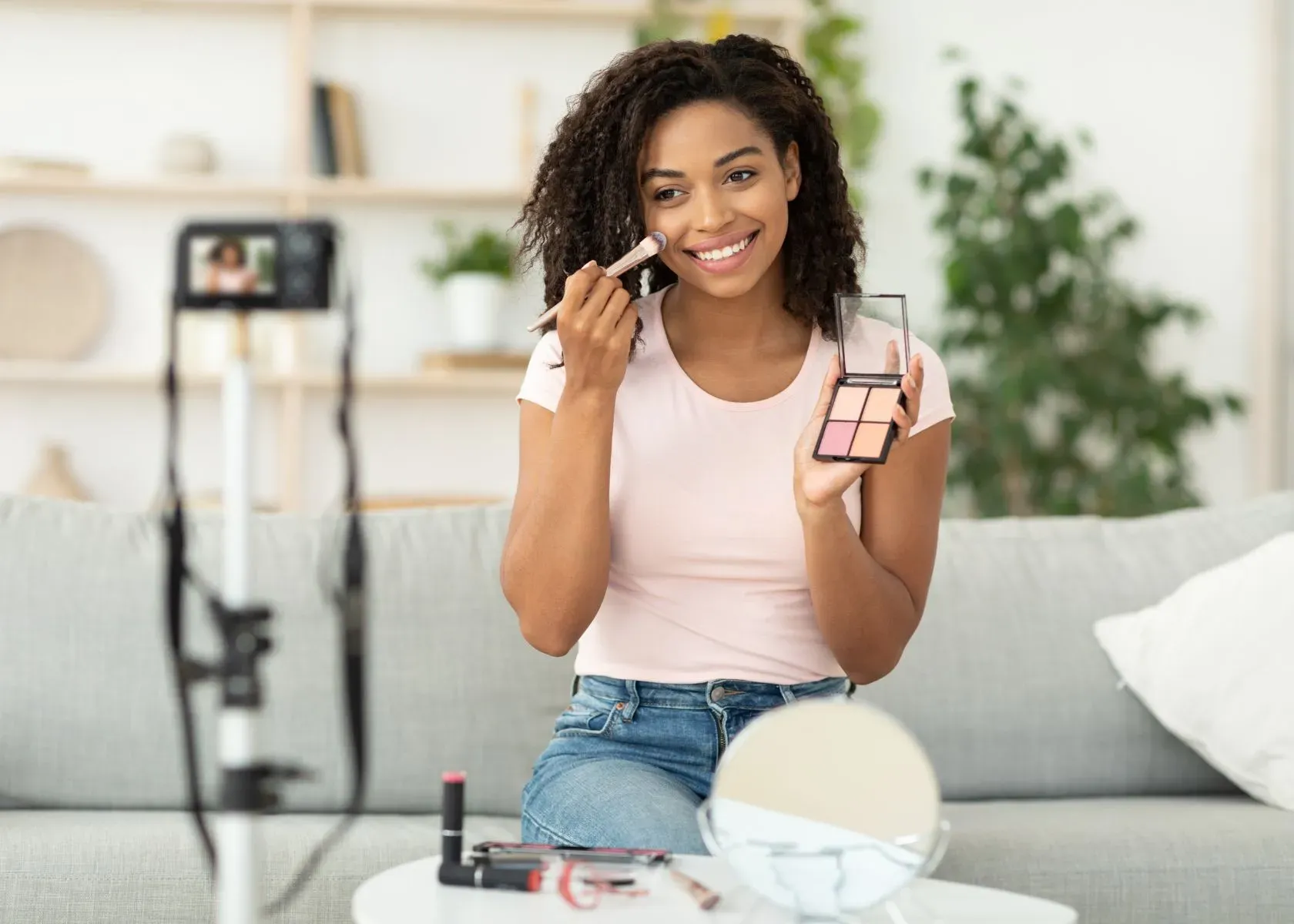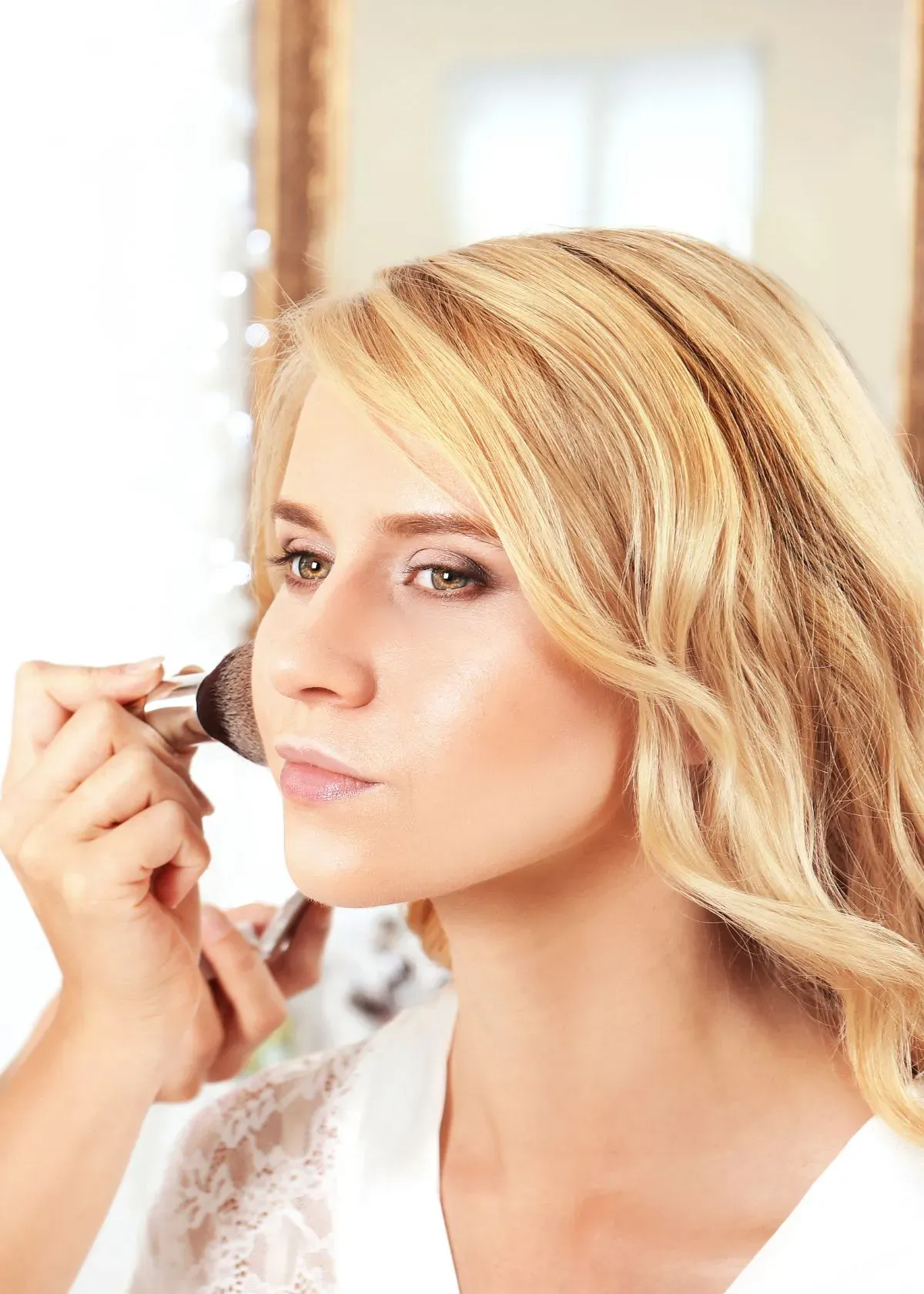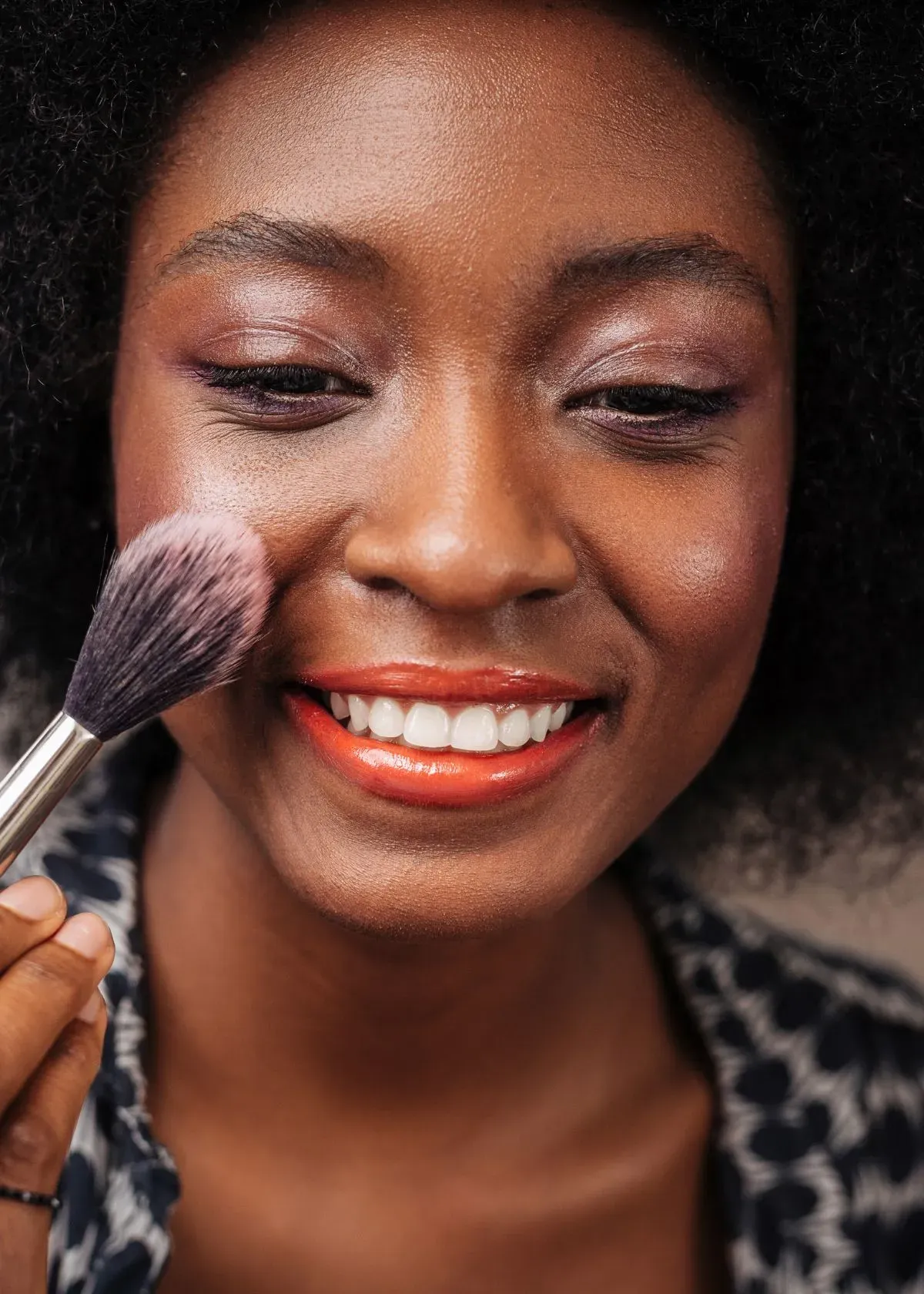Blushing happens to everyone, but have you ever wondered how it shows up on dark skin? It's one of the physiological signs and a body reaction that can make your cheeks turn red or pink when feeling shy or excited. Blushing might not be so obvious if you have dark skin, though. But, based on studies, skin tone moderated the link between blushing intensity and self-consciousness.
Sometimes, only family members know them well enough to spot the tell-tale signs of blush on darker complexions.
As we hone in on what blushing looks like beyond fair skin, we uncover important stories about our shared human experiences and understand more about each other along the way. Be ready to learn something new.
- People with dark skin do blush, and while it may not be as visible as on light skin, they experience similar emotions like embarrassment or excitement that cause blushing.
- Dark-skinned individuals might show blushing more evidently if they have red or pink undertones in their skin, which can enhance the reddish hues when they flush.
- Cultural differences influence how blushing is perceived and expressed across communities; some value verbal communication over nonverbal cues such as blushing.
- Blushing in darker skin tones can be challenging to detect due to physiological factors like melanin levels and requires closer observation for recognition.
- Recognizing that bias and stereotypes exist about blushing on dark skin is important for fostering understanding and inclusivity of diverse expressions of emotion.
The Concept of Blushing and its Significance for Darker Skin Tones

Moving from the basics, let's delve into how blushing manifests in those with darker complexions. Despite common beliefs, people with dark skin do experience blushing. This universal reaction can signal emotions like embarrassment or excitement; however, the reddish or pinkish hues associated with flushed cheeks are often less visible on darker skin tones due to higher melanin levels.
Blushing carries significant social cues and communicates a range of emotions without words, as it is one of the physiological responses. For individuals with dark skin, this physiological response is just as relevant but may go unrecognized by others because of its subtlety.
People with cooler-toned dark skin might display more noticeable red or pink undertones when they blush, which slightly alters their overall complexion. Although detecting a natural blush on someone's face whose skin is richly pigmented can be challenging, it does not negate the internal experiences that cause one to blush in the first place – from shyness to pride.
The act of blushing itself is complex and involves various physiological changes, such as increased blood flow to the face. Even if these changes are less observable in those with deeper complexions, they carry similar emotional weight and meaning as they would in lighter-skinned counterparts.
It's essential to understand that blushing for black individuals and people of African descent has nuanced visibility but remains an integral aspect of human expression across all skin tones. People with dark skin can easily feel facial warmth but not a change in skin color.
Factors Affecting Blushing for Darker Skin Tones

Blushing propensity, self-consciousness, and cultural differences all play a role in how blushing is perceived and experienced for individuals with darker skin tones. Understanding these factors can provide insight into the unique experience of blushing for people of color.
Blushing Propensity
Blushing propensity in individuals with darker skin tones varies, as not all dark-skinned people exhibit noticeable blushing. The ability to detect blushing in darker skin may depend on factors such as the presence of red or pink undertones, which can enhance the reddish hues and make blushing more visible.
While it may be challenging to discern, the physiological response of blushing still serves a purpose for those with darker skin.
Factors influencing blushing propensity include cultural differences and self-consciousness. Dark-skinned individuals with cool-toned complexions might experience difficulty detecting blushes unless they have prominent red or pink undertones that amplify the color change.
Self-Consciousness and Social Anxiety
Self-consciousness and social anxiety can exacerbate the difficulty dark-skinned individuals may experience in detecting blushing. This heightened self-awareness can lead to an increased focus on physical reactions, potentially intensifying feelings of discomfort or embarrassment.
Social anxiety in people with darker skin tones may be compounded by the challenge of discerning blushing, as it may make them more self-conscious about their emotions being visible to others.
Cultural influences and societal pressures can also play a role in how self-consciousness and social anxiety manifest within different communities. These factors might affect how individuals perceive their own blushing experiences, contributing to varying levels of concern about outward signs of emotion.
Generally, people who are more self-conscious experience more blushing.
Cultural Differences
Cultural differences affect how blushing is perceived and interpreted. Different communities may have varying attitudes towards blushing, affecting how individuals with darker skin tones experience and express their emotions.
In some cultures, blushing may be viewed as a sign of embarrassment or modesty, while in others, it might not hold the same significance. This diversity of cultural perspectives can influence the awareness and understanding of blushing on dark skin.
In various cultures, societal norms and traditions play a significant role in influencing expressions of emotion such as blushing. Some cultures may place more emphasis on verbal communication rather than nonverbal cues like blushing, impacting how individuals from different cultural backgrounds perceive and interpret this physiological response.
Challenges of Detecting Blushing on Dark Skin

Detecting blushing on dark skin poses challenges due to physiological differences and the influence of bias and stereotypes, making it important to understand how blushing may appear on darker skin tones.
Read more to learn about the significance of blushing for individuals with dark skin.
Physiological Differences
Blushing in dark-skinned individuals may not be as visually apparent as in fair-skinned individuals due to physiological differences. The change in skin color that characterizes blushing can be virtually imperceptible on darker skin tones, making it challenging to detect without close scrutiny.
Some dark-skinned people with red or pink undertones, however, may exhibit a more noticeable reddish hue when they blush.
The technical definition of blushing involves visibly turning red or pink – a change that may not be easily discernible in melanated skin. Moreover, the presence of significant dark pigmentation can further obscure any visible signs of blushing, rendering it undetectable except by very close acquaintances.
Bias and Stereotypes
Bias and stereotypes about blushing on dark skin can lead to misunderstandings or assumptions. Physiological differences in darker skin tones may lead to biases where people believe that individuals with dark skin do not experience blushing, which may perpetuate misconceptions.
Stereotypes surrounding blushing often overlook the nuanced experiences of individuals with darker complexions. These preconceived notions can impact social interactions and contribute to a lack of understanding about the significance and appearance of blushing in people with dark skin.
How Blushing may Appear on Dark Skin?

Blushing on dark skin may appear as enhanced undertones, with the role of blood flow contributing to a flushed appearance on deeper skin tones. To read more about the concept of blushing and its significance for darker skin tones, keep reading this article.
Enhanced Undertones
Blushing in dark skin with red or pink undertones may lead to an intensified appearance of reddish hues. These undertones can enhance the natural coloring of the skin, making any blushing more noticeable.
In individuals with cool-toned dark skin, the enhanced undertones may make any blushing more perceptible than in those without such undertones.
Individuals with deep skin tones may experience an enhancement of their natural complexion when they blush. This enhanced appearance is due to the combination of their darker base tone and the increased blood flow associated with blushing.
The Role of Blood Flow
Dark-skinned individuals may experience blushing differently due to the role of forehead blood flow. The depth of skin pigmentation in darker tones can impact how noticeable blushing is. This means that the increase in blood flow and resulting change in color may not be as visible on dark skin compared to fair skin.
Blushing, typically characterized by a red or pink hue on the cheeks, may appear more enhanced in those with red/pink undertones, influencing the visibility of blushing on darker complexion.
The variation in how blood flow impacts darker skin tones underscores the complexity of detecting blushing. Despite this challenge, understanding these nuances can enrich our appreciation for the diverse ways individuals experience and express emotions across different skin tones.
What Does Blushing Look Like on Dark Skin - FAQs
Blushing can be difficult to see on darker skin tones. In these FAQs, we'll answer some common questions about what blushing looks like on dark skin and how to tell if someone with a darker complexion is blushing.
We'll explain the physiology behind blushing and how it presents different skin tones. We'll also provide tips for enhancing and detecting blush response on darker skin.
Can people with dark skin actually blush?
Yes, people with dark skin can experience blushing, which may appear as a subtle reddish tint or a pinkish glow due to red-pink undertones in the skin.
How does blushing look different on dark-skinned individuals compared to fair-skinned ones?
On dark-skinned people, blushing might not be as visible as it is on those who are fair-skinned because the change in color can be more difficult to detect against the darker background of their skin tone.
What does blushing on darker complexions typically look like?
Blushing on darker complexions can look like a rosy cheeks effect, with a crimson hue or ruddy complexion that is sometimes described as a warm flush over the person's normal skin color.
Is it true that detecting blushing is harder in dark-skinned people?
Yes, it can be more challenging to see when someone with a cool-toned dark complexion blushes because their natural melanin-rich skin may mask the redness or flushing common when one experiences embarrassment.
Are there cultural differences in how we understand and see blushing across various skin tones?
Absolutely! Different cultures may recognize and interpret the drawing behavior of blushing differently; some might place less emphasis on the noticeable redness seen commonly in a white person's dictionary definition of turning red in the face and focus instead on other cues for embarrassment or emotional responses.
Conclusion
Understanding how blushing appears on dark skin involves considering factors such as blushing propensity and the challenges of detecting it.
The practicality lies in acknowledging that blushing may not be overtly visible, but its significance remains valid for individuals with darker skin tones.
Emphasizing the importance of recognizing and appreciating blushing on dark skin can lead to a more inclusive understanding of this natural physiological response. If you have a dark skin tone, let us know what it looks like when you blush in the comments section below.
Read More About Skin Tones and Blushing





